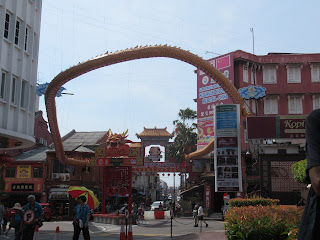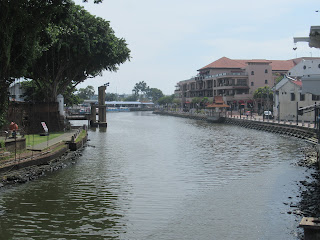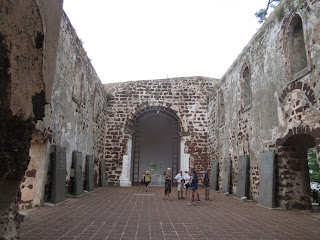Malacca
I was up early for a walk past some of the sightts that I had seen the night before. We had had aperitifs before dinner along the river, watching the world go by. And there were still plenty of your boats going past even before breakfast.Another tour boat...
...and just next door were more entretainment options. The ferris wheel is brightly lit at night just as the boats are but it was early and not open yet.
Another of the many bridges over the rivr and another tour boat.
Looking back at another bridge, reminiscent of Venice with the ferris wheel in the background.
More bridges...
...and then I reached the colourful part of the river lined with cafes and restaurants, which reminded me of La Boca in Buenos Aires...
...more photos of the riverfront...
...and a quiet section of the river, cordoned off and protected by a walkway and hoardings to give some piece to some wildlife. We had seen both Water monitors and otters in the river the night before, but there was nothing to see during the day.
Every where seems to have some murals.
Jonkers Street, the entrance to Chinatown.
The entrance from just a bit further back with the giant dragon.
A view along the river.
We were standing on the bridge between the Portuguese, later Dutch part of the town and behind the camera, the Asian or Cinhstown sector.
The townhall and to the left, the clock tower...
...the Protestant church of the Dutch, whereas the Portuguese Catholic church was at the top of the hill...The thinnest house in the city.
And everywhere we went, there where these cycle rickshaws, covered in ghastly colours, cartoon characters, floral displays and loud naff music.
Part of the Dutch quarter that was ostly built and lived in by the Chinese.
A retored Dutch shop.
A detail of a shop with the shutter up, but if let down, it formed a counter.
The house of the richest man in the neighbourhood. Oringinally the houses were taxed by their width so houses were narrow and deep. This takes up several plots and emphasises his wealth.
The house with a view of the gates.
A hotel, almost a museum as everything inside is original dating back hunderds of years and including a lot of antiques.
The central lightwell and stairs.
A view fro the door past the lightwell to reception at the far end.
And Harony Street, as it has a lot of different religious sites all along the same road. A Taoist temple...
...a Buddhist temple...
...the minaret of a mosque...
...and the entrance to the mosque...
...and a Hindu shrine, all along the same road within metres of each other.
A tourist attraction of a viewing platform that visitors enter at ground level and the whole ring structure pulls itself up the central column. In the background is a view of the Malacc Straits, the busiest shipping strait in the worldThe separate belltower of the \Portuguese Catholic church on the top of the hill.
The shell of the old church...
...inside the church.
The entrance to the last gate standing. The other three gates were demolished by the British.
One of the offices of British rubber companies, this one belonged to Sime Darby but Dunlop, London Rubber Co and British Tyre and Rubber also had offices nearby.




























































